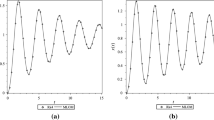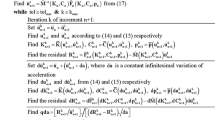Abstract
Discontinuous deformation analysis (DDA) is a numerical method for analyzing the deformation of block system. It employs unified dynamic formulation for both static and dynamic analysis, in which the so-called kinetic damping is adopted for absorbing dynamic energy. The DDA dynamic equations are integrated directly by the constant acceleration algorithm of Newmark family integrators. In order to have an insight into the DDA time integration scheme, the performance of Newmark time integration scheme for dynamic equations with kinetic damping is systematically investigated, formulae of stability, bifurcation, spectral radius, critical kinetic damping and algorithmic damping are presented. Combining with numerical examples, recognition and suggestions of Newmark integration scheme application in the DDA static and dynamic analysis are proposed.
Similar content being viewed by others
References
Shi G H. Discontinuous deformation analysis: A new numerical model for the statics and dynamics of block systems. Dissertation of Doctor Degree. University of California, Berkeley. 1988
Wu J H, Ohnishi Y, Nishiyama S. Simulation of the mechanical behavior of inclined jointed rock masses during tunnel constructions using discontinuous deformation analysis (DDA). Int J Rock Mech Min Sci, 2004; 41: 731–743
Jiang Q H, Zhou C B, Qi Z F. Discontinuous deformation analysis method based on Newmark integration algorithm. Chin J Rock Mech Eng, 2009; 28: 2778–2783
Jiang Q H, Chen Y F, Zhou C B, et al. Kinetic energy dissipation and convergence criterion of discontinuous deformations analysis (DDA) for geotechnical engineering. Rock Mech Rock Eng, 2013; 46: 1443–1460
Chang C S, Acheampong K B. Accuracy and stability for static analysis using dynamic formulation in discrete element methods. In: Williams J R, Mustoe G G W, eds. Proceedings of the 2nd International Conference on Discrete Element Methods (DEM), IESL Publications, 1993. 379–389
Newmark N M. A method of computation for structural dynamics. Proc ASCE, 1959; 85: 67–94
Hughes T J R. Analysis of transient algorithms with particular reference to stability behavior. In: Belytschko T, Hughes T J R, eds. Computational methods for transient analysis, Amsterdam: Elsevier Science, 1983. 67–155
Bathe K J, Wilson E L. Stability and accuracy analysis of direct integration methods. Earthq Eng Struct D, 1972; 1: 283–291
Hilber H M, Hughes T J R, Taylor R L. Improved numerical dissipation for time integration algorithms in structural dynamics. Earthq Eng Struct D, 1977; 5: 283–292
Hilber H M, Hughes T J R. Collocation, dissipation and overshoot for time integration schemes in structural dynamics. Earthq Eng Struct D, 1978; 6: 99–117
Dokainish M A, Subbaraj K. A survey of direct time-integration methods in computational structural dynamics—I. Explicit methods. Comput Struct, 1989; 32: 1371–1386
Subbaraj K, Dokainish M A. A survey of direct time-integration methods in computational structural dynamics—II. Implicit methods. Comput Struct, 1989; 32: 1387–1401
Wang J T, Zhang C H, Jin F. On the accuracy of several explicit integration schemes for dynamic equation with damping. Eng Mech, 2006; 23: 1–5
Wang C Y, Chuang C C, Sheng J. Time integration theories for the DDA method with finite element meshes. In: Proceedings of 1st Int. Forum on Discontinuous Deformation Analysis (DDA) and Simulations of Discontinuous Media, TSI, Albuquerque, NM, 1996. 263–287
Doolin D M, Sitar N. Time integration in discontinuous deformation analysis. J Eng Mech, 2004, 130: 249–258
Shi G H. Contact theory. Sci China Tech Sci, 2015, 58: 1449–1495
Liu T Y, Li Q B, Zhao C B. An efficient time-integration method for nonlinear dynamic analysis of solids and structures. Sci China-Phys Mech Astron, 2013; 56: 798–804
Zou J X, Yu K P. Dynamics of Structures. 2nd ed. Harbin: Harbin Institute of Technology Press, 2009
Underwood P. Dynamic relaxation. In: Belytschko T, Hughes T J R, eds. Computational Methods for Transient Analysis, Amsterdam: Elsevier Science, 1983. 245–265
Shi G H. Manifold method. In: Proceedings of the First International Forum on Discontinuous Deformation Analysis and Simulations of Discontinuous Media, Berkeley, California, USA, 1996. 52–204
Author information
Authors and Affiliations
Corresponding author
Rights and permissions
About this article
Cite this article
Lin, S., Xie, Z. Performance of DDA time integration. Sci. China Technol. Sci. 58, 1558–1566 (2015). https://doi.org/10.1007/s11431-015-5893-1
Received:
Accepted:
Published:
Issue Date:
DOI: https://doi.org/10.1007/s11431-015-5893-1




